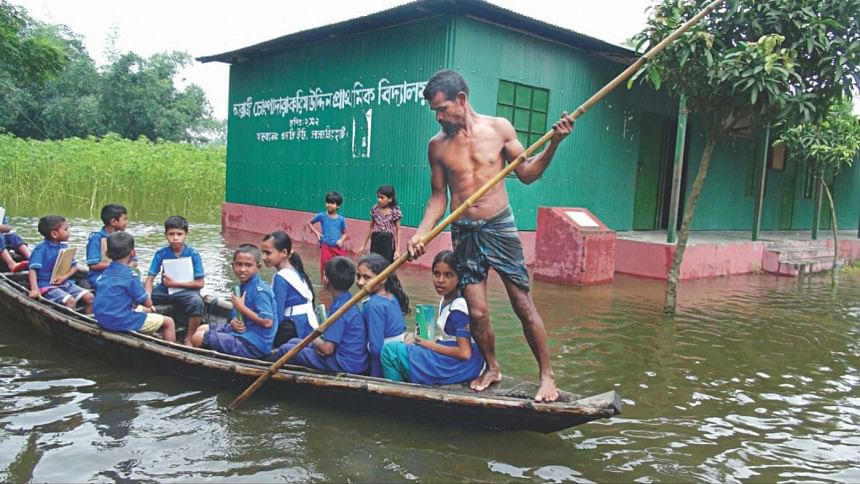Living with floods and reducing vulnerability in Bangladesh

Every year, Bangladesh suffers from floods that cause loss of life, livelihoods, crops and property. However, in certain years, due to heavy rainfall and the flow of upstream water, floods become devastating. The floods of 1988, 1998, 2004, 2007 and 2017 are examples of when Bangladesh has seen the severity of floods in terms of duration and damages. The floods of 2020 have also emerged as one of those natural disasters, since the shocks are being felt by a large number of people for a prolonged period. It has been more than 40 days since the northern, north-eastern and south-eastern regions of Bangladesh are experiencing floods. Jamalpur, Kurigram and Lalmonirhat districts are reported to be among the most affected, while Rajbari, Bogura and Manikganj are the moderately affected districts. In more than 33 districts of the country, about six percent of the total population of Bangladesh have been affected so far.
The impact of floods is multi-dimensional, which encompasses economic and social aspects. Although floods are still ongoing and the actual cost of damages will be estimated by the Department of Disaster Management of the Ministry of Disaster Management and Relief once floods are over, some preliminary reports have assessed their impacts in 2020. The early assessment by the Needs Assessment Working Group (NAWG), which is a platform for government and non-government humanitarian agencies, indicates damages in several areas. These include loss of agricultural production, fisheries, livestock and poultry, and damages to food stock, infrastructure, roads, culverts, embankments, local markets, schools and health clinics. This has resulted in not only shortages of food, but also contributed to a lack of pure drinking water and a barely functional sanitation system. Livelihood systems have been disrupted due to loss of employment and the limited scope of income earning activities. Hence, livelihood, food security and healthcare are currently the major concerns among a large number of flood-affected people.
This year's floods are like a double whammy for Bangladesh since the country is fighting the coronavirus pandemic along with the rest of the world. Several people were already without jobs and income for the last few months because of Covid-19. The situation has been aggravated by the floods, especially in affected districts such as Jamalpur, Sunamganj and Netrokona, where people were already vulnerable because of the pandemic. While people had to be evacuated to shelters from their inundated and damaged homes, health protocols of Covid-19 such as physical distancing, hand wash and mask use were not maintained. This created risks of the spread of coronavirus among the flood affected people. Also, the floods have made it difficult for people to access healthcare since mobility is restricted and healthcare services have been disrupted. Lack of healthcare facilities at the local level may worsen the coronavirus situation, in addition to the usual risk of increased waterborne diseases and infections during floods. Women, particularly pregnant women, as well as girls, children, elderly people and persons with disability, are more vulnerable due to the disrupted healthcare system.
The government has initiated relief and rehabilitation measures in affected areas, but the adequacy and coverage of relief have to be expanded in view of the demand for support. The government relief measures are mostly targeted based on the level of poverty. However, during floods, people from other socioeconomic backgrounds also become susceptible. The relief needs to be distributed among those who are facing survival challenges during floods, rather than going by the poverty list.
Since the impact of floods is location specific, the allocation of relief has to be based on the need of each specific locality. Moreover, the types of flood relief have to be different from the usual relief items such as cash and food. During floods, people need items such as cooked food, drinking water and medicine. Keeping in mind the coronavirus pandemic, special health related support will be needed this time as well.
Ensuring efficiency and effectiveness in relief distribution is critical to make the best use of the limited resources that the country has. A common criticism of the social safety net programmes in Bangladesh is that they suffer from lack of accountability. There are both inclusion and exclusion errors in the beneficiary lists, which include many who do not need support while excluding several others who do. This could be the case in the distribution of flood relief too. The local administration should involve non-government and community level organisations in the identification and selection of flood affected people, and also in the distribution of relief. For the sake of transparency, the local administration should publish the list of recipients so that local people can see for themselves who have received relief and who have not.
The rehabilitation of food supply will require attention to both crop and non-crop sectors, including agriculture, fisheries and livestock. According to experts, the floods may persist till September. This risks Aman cultivation and food security. Therefore, the government has to procure enough rice from domestic and international markets. In case of rice imports, a realistic assessment of the need should be made to protect the interests of both farmers and consumers. Timely decision-making on rice imports by policymakers is crucial since the rice exporting countries are likely to take restrictive measures during the pandemic period.
As the impacts of natural disasters such as flood are mostly similar every year, one would expect that the recovery measures are also well known. However, after every disastrous flood, the same issues surface afresh. For example, how efficient has the early warning system been, what has been the preparations including maintenance of shelters and the evacuation system, why were the embankments not repaired in time, and why was the flawed infrastructure not abandoned already?
From media reports, it is clear that crops have been damaged in places where there are no embankments. Districts with higher water levels than others have nevertheless been less affected, as they have better embankments and infrastructure. Reconstruction of damaged embankments have to be done regularly. Besides, some infrastructure such as culverts cause waterlogging, which have to be replaced by bridges. For effective infrastructure development, coordination among various ministries and departments—including the Ministry of Water Resources, the local government engineering department, and the roads and highways department—is necessary. The role of the Ministry of Finance is also very important since more resources are needed and timely disbursement of funds is crucial. One of the concerns regarding project implementation in Bangladesh is its cycle. The delay in the initiation of the project implementation process has been a perennial problem. However, if we want to reduce the sufferings induced by floods, the work on repairing embankments should be finished by March of the coming year.
Each year, when the country faces floods, these issues resurface even though floods are not unusual in Bangladesh. About 17 percent of Bangladesh remains underwater throughout the year, which is needed for environmental balance. Regular floods inundate around 18 percent of Bangladesh. So, approximately 35 percent of the country is under water during regular floods. Therefore, Bangladesh will have to learn to live with this situation. Indeed, Bangladeshi people have been coping with this annual deluge historically. What is needed most is to learn how to manage floods better with minimum damage of lives and livelihoods, and how to reduce flood-induced vulnerability. Adapting to floods is the key strategy for Bangladesh and a crucial part of its policy on disaster risk reduction.
Dr Fahmida Khatun is the Executive Director at the Centre for Policy Dialogue.

 For all latest news, follow The Daily Star's Google News channel.
For all latest news, follow The Daily Star's Google News channel. 



Comments